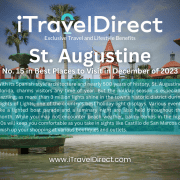Prague #10 in Best Places to Visit in December of 2023
Why Go To Prague
If you’re willing to brave the cold, travel to Prague for a fun and festive winter vacation. The city turns into a winter wonderland in December, with snow-dusted buildings and Christmas markets selling everything from locally made jewelry to toys to Christmas ornaments. Those with little ones in tow should try to arrive in early December when the annual St. Nicholas Eve event takes place. During this traditional celebration, you’ll see the Czech Republic’s version of St. Nick, along with his angel and devil guides, hand out candy and other treats as they walk around the city.
A prosperous and bustling city, Prague now attracts more tourists than ever. But its picturesque downtown veils both a dark legacy and a resilient past. Dating back to about A.D. 870, Prague has withstood numerous overthrows, invasions, fires, and floods. It’s this reputation for survival and perseverance that has made the Czech capital so fascinating. Today, its storied churches, narrow streets, daunting hilltop castles, and statue-lined bridges create the scene of an urban fairy tale. Even the most jaded traveler would have trouble resisting this city’s charms.
Prague was once a hidden gem, overshadowed by its flashier neighbors to the west. But the city couldn’t keep its marvels a secret for too long – now, it’s a haven for travelers seeking awe-inspiring experiences at affordable prices. Even today, top attractions – including the famous Charles Bridge and the historic Prague Castle – offer free admission and many hotels offer rooms at a fraction of the cost of other European cities. But this bargain-hunting legacy has a ticking clock on it, so if you’re hoping to find a fire-sale price, now’s the time to do so.
Best Months to Visit
The best times to visit Prague are the spring and early fall when the weather is mild and there are fewer crowds. Because of the city’s generally chilly climate, the warmer summer months (average high temperatures hover in the low to mid-70s) see the largest influx of tourists – which means higher hotel rates. The spring and early fall, however, offer clear skies, highs ranging from the mid-50s to the upper 60s and much lower room rates. Prague also shines during the festive Christmas season but be warned that the city sees a fair amount of snow and highs don’t rise above the mid-30s.
Culture & Customs
The Czech Republic is a Parliamentary Republic that was established in 1993 following the Cold War. But Prague and the Czech state have been important centers of business, government and commerce for centuries. Czech citizens are known for being more formal and reserved than some other European cultures yet friendly, too. In many Prague bars and restaurants, groups can share tables if there is room, even if they don’t know each other. After eating, be sure to place your fork and knife side by side on your plate if you want the waiter to take your plate away.
The Czech Republic uses the koruna and major credit cards are accepted at most establishments throughout Prague. Since the koruna to U.S. dollar exchange rate fluctuates, be sure to check what the current exchange rate is before you go. Tipping 10 to 15 percent is common practice for good service, but be mindful to hand it directly to your server instead of leaving it on the table. Like many European destinations, local Prague citizens respond kindly to travelers who try the local Czech language, so buy a phrase book before traveling. Some helpful phases, such as “thank you” (Dekuji), “excuse me” (S dovolením) and even “do you speak English?” (Mluvíte anglicky?), will come in handy.
What to Eat
Czech cuisine isn’t as well-known or sought after as some of its European neighbors, but that doesn’t make it any less delicious. In its more than 1,100-year history, the country’s fare has been influenced by nearby countries like Germany, Austria and Poland. Typical meals consist of meat – and lots of it – alongside gravy and knedlíky (bread dumplings). This configuration makes up one of the quintessential Czech dishes, svícková, which also includes a vegetable cream sauce, whipped cream and cranberry sauce. You’ll also find hearty dishes, such as bramboráky (potato pancakes), which are a popular street food found in neighboring countries. Those with a sweet tooth can find unique Czech dishes like ovocné knedlíky (fresh fruit dumplings topped with curd cheese) and perníky (gingerbread cookies) as well. For a comprehensive overview of the city’s dining scene, sign up for a food tour.
But where Prague culture really shines is its beer. The Czech Republic has frequently been named the top beer-consuming country in the world and for good reason – its beer is top-notch. After all, Pilsners were invented only 60 miles southeast in Pilsen. As such, pub culture is very important. Be mindful that once you start ordering, the drinks will keep coming until you ask your server to stop or to bring the check. As a last resort, place your coaster over your glass.
Because Prague welcomes hordes of travelers each year, beware of tourist trap restaurants that offer watered-down versions of authentic dishes. Some establishments, such as U Medvídku and Pivovarský Klub, offer traditional dishes along with lots of local beer in bottles and on tap. For even more ambiance, you can have a meal on the outdoor terrace of Mlýnec, which offers one-of-a-kind views of the Charles Bridge. If you’re after a more gourmet experience, the Michelin-starred La Degustation Boheme Bourgeoise is sure to satisfy.
Safety
Prague is generally considered a safe city, especially for one of its size. The main danger to be aware of is pickpockets, who hover around the tourist hot spots like the Astronomical Clock and Charles Bridge. Also, keep an eye out for them when using mass transit. Some taxi drivers have been known to overcharge tourists. Phone for a taxi or go to an authorized taxi stand (they are marked with red and yellow signs) to reduce your chances of being swindled.
Getting Around Prague
The best way to get around Prague is on foot or by public transportation. Exploring this city on foot is a treat for the eyes, plus many of the most noteworthy attractions are within walking distance of one another. What’s more, several of the city’s top guided tours are walking tours. There is an extensive public transportation system that includes bus, tram and subway lines.
To get into the city from the Václav Havel Airport Prague (PRG), you can take the No. 119 bus to Nádraží Veleslavín metro station on the green line (line A) to the city center. You could also spring for a taxi, which will cost you about 450 to 560 koruna (about $20 to $25) to the city center, but be aware that many taxis have a reputation for overcharging.
On Foot
Numerous and compact, the historic districts of Prague are best explored with your own two feet. There is a lot to see, so your legs will probably grow tired. When this happens, hop on public transit to whisk you back to your hotel or off to the next neighborhood. If you want a little help navigating on foot, consider signing up for one of the best Prague tours, many of which require nothing but your own two feet.
Metro
There are three, color-coded underground metro lines, which operate from around 5 a.m. to midnight. Metro Line A (green) offers access to the most tourist attractions, so it may be convenient to select a hotel near one of the stations on this line. Ticket and transfer fares can be confusing, so make sure to buy the correct ticket. A basic ticket costs 32 korun (about $1.40) and allows 90 minutes of unlimited travel throughout the network of buses, trams and subways. Short-term, 30-minute tickets, which cost 24 korun (or about $1) are available as well as 24-hour passes (110 korun or about $4.90) and three-day passes for 310 korun (about $13.75). When purchasing tickets from machines, make sure you have coins (most don’t accept notes).
Tickets must also be stamped (or validated) at the machines on board for trams and buses or at the station (most are near escalators or stairs) for metro rides. Since there are no turnstiles or barriers to entering the train, it can be easy to make the mistake of not validating your ticket. But you’ll want to be sure to stamp your ticket before getting on the metro, or else you might find yourself subject to a fine. If you’re carrying large bags, you’ll want to factor in an additional 16 korun (about $0.70) for luggage transport.
Tram
The numerous tram lines service practically the entire city. Unlike buses, you’ll never have to hail a tram, as they make every stop. You’ll most likely spend the majority of your time on either the No. 22 or 23: Deemed “the tourist trams,” these two service popular attractions like Prague Castle and the National Theatre. They’re also notorious for attracting pickpockets, however, so keep your valuables close when riding. Trams operate between 4:30 a.m. and midnight (there are night routes, but they don’t run as frequently and service is limited). You can use the same tickets on the tram as you use on the metro.
Bus
Prague’s bus system covers the outskirts and will be of little help during your stay. However, the bus does come in handy for getting to and from the airport. From the airport, you can take bus No. 119 to Nádraží Veleslavín metro station and then take the Line A (green) into the city. The bus uses the same types of tickets as the metro and the tram.
Car
There is no need to rent a car if you plan on staying in the city: The roads are frustrating and parking is expensive. But if you want to explore outside of Prague, you’ll find a car might come in handy. You will find rental agencies scattered throughout the city and at the Prague airport. And here’s a tip: Many of the local car rental agencies offer lower rates than the international firms. Also, you will need an international driver’s license if you are planning to rent a car. You must obtain your international driving permit before leaving the U.S. You can apply for one here.
Taxi
If you need to get somewhere quickly, a taxi is your best bet, but ride with care. Drivers have been known to swindle unsuspecting tourists. Consult with your hotel concierge on appropriate fares for top points around the city. If you can, ask your hotel or the restaurant you’re dining at to call you a cab – they will connect you with a trustworthy company. If you must hail a cab from the street, make sure to agree upon a price before getting into the taxi and look for visual cues that it’s official: Cabs must have a yellow roof lamp that is permanently installed; “TAXI” must be printed in black letters on both sides. The driver’s name, license number and rates should be printed on both front doors. It’s also a good idea to write down the address of your destination before you head out to assist with the language barrier. AAA Taxi and City Taxi are two reputable companies in Prague. If you’d rather use your smartphone to connect with a reputable driver, you can use apps like Uber and Liftago.
Start Saving with iTravelDirect’s Exclusive Travel and Lifestyle Benefits Membership
CLICK HERE to Test-Drive our Guaranteed Savings
We offer a 110% Price Guarantee – Find a lower price anywhere online and we will refund you 110% of the difference.
CLICK HERE for a full list of services and Membership Discounts.
When you join iTravelDirect, you’ll have full access to all club benefits.
Your membership gives you the freedom to travel when you want, to where you want.
And you won’t find lower rates anywhere, guaranteed. So, pack your bags and start planning that vacation of a lifetime today!












Leave a Reply
Want to join the discussion?Feel free to contribute!